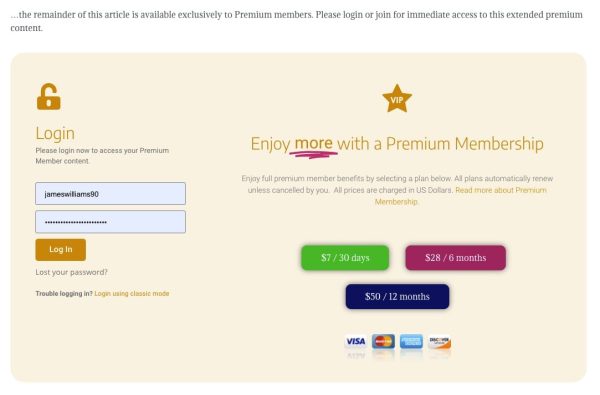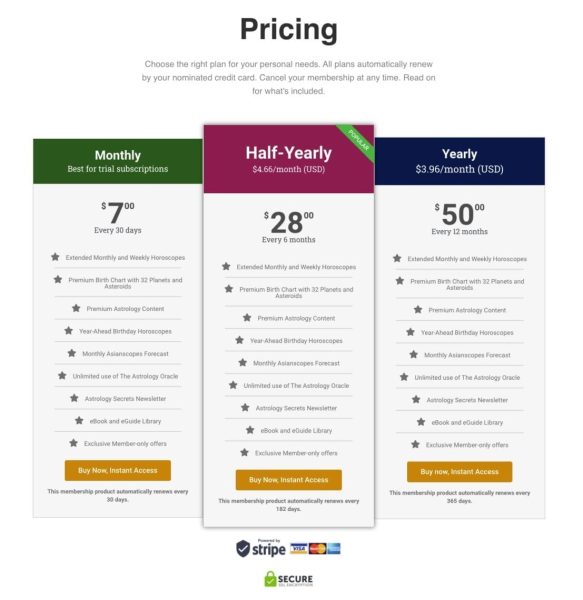Most people see a website as a passive way of generating interest in their content, but if you are someone who loves to write great content, then a membership website might be a worthwhile investment. Membership websites are excellent income generators and also help to grow visitor loyalty.
When it comes to execution, the challenge is that most people are great at writing content, but aren’t always that savvy when it comes to the business of setting up a profitable, scalable membership business. In this post, I will explore how you can take your audience from free content to a membership model.
Is A Membership Site Right for Me?
Before we get in too deep, I want to issue a general warning. Membership websites aren’t a get rich quick proposition and they are not simple to manage. They are not for everyone.
The most successful membership sites already have established audiences, great content and loyal visitors. Engagement is also important and I like to think of engagement as the ‘secret sauce.’ When your website visitors want more content from you than you can possibly muster, this is a strong signal that your site is right for Membership. This could manifest itself in several ways, like an inbox overflowing with content ideas, increasing volumes of comments or viral sharing of your content.
What Is A Membership Site?
Let’s start by stating what I mean when I say membership site. To me a membership site that offers content that is only available once people have signed up and/or paid for it. There has been an exchange either of content details or cash in return for viewing content that is locked away.
Membership websites don’t always need to have a cash exchange, but it certainly helps when you might be considering making this a profitable part-time or full-time job. With membership, it’s those who complete the exchange who get to view content or use member-only features.
As a blogger what this will provide you with an income where earlier you were giving away content for free and it also gives you the means to grow your website. More revenue equals funds you can use to provide better support, market your content, or spend more time investigating and writing great content.

Why Would I Want To Convert My Site To Membership?
Converting your site to membership isn’t done on a whim. It’s a strategic move that is complex and it requires a complete shift of focus. A rolling stream of income from your site helps pay the bills, and those who make the switch describe it is as transforming the website from a hobby into a business. This is really a good way of thinking about it.
As a hobby, you are pouring money into your passion. As a business, you are considering the revenue that your action will bring with a focus on making what you do profitable in the short to medium term. In this way, a membership ‘business’ should be changing the way you think about your site.
But there are other advantages apart from removing the cost. Membership can actually increase loyalty to your content and brand. Think about something you’ve paid hard-earned cash for. If you’re like me then you value it more than those things that are free.
I love getting free ebooks from websites. In fact, I’m a bit of a sucker when it comes to people giving away content. Most people give it away content for my email address on a mailing list or some other small inconvenience. I will generally sign up, take the ebook, then unsubscribe. It doesn’t cost me much except my time to unsubscribe and delete a few emails.
But then what happens to the content.
Well, I usually download it and then it sits in a folder on my computer. I find often I don’t read it cover to cover. Why? I think it’s because it’s free. I didn’t seek it out and it fell in my lap like unplanned good luck. Because it’s free I probably don’t value it enough to read it cover to cover, which is a stark contrast to say those Kindle ebooks I pay good money for on Amazon.
If I have forked out money, I’m much more likely to pay attention and even read it cover to cover. I may even write a review if I think it’s good, or to warn people not to spend their money if it’s too light on valuable content. The point I’m making is this – people’s engagement increases when the product or service has an increased value attached.
Memberships Provide Increased Lifetime Revenue
Memberships provide ongoing revenue, unlike an eBook which is a one-off purchase. Over time memberships can create a mass revenue as people’s subscriptions renew month-on-month or year-to-year.
From a marketing perspective, the professionals tell us it is much easier to sell to people who have already bought something from you. If you already sell merchandise, eBooks or courses, then Membership can be an added way to get more enrollments or sales. There are many tactics you can employ to sell to people who are already members, but the key take away is this… once people have experienced the sales process, they are more likely to buy from you again. All you need to do is ask!
Membership Is About the Niche
There are four basic steps you need to follow if you want to create a membership website. You can probably already identify an audience with key interests, also known as niches. Finding the right niche is critical. You don’t want to be throwing good money after the wrong niche. You want to make sure that you’ve got a solid idea of what is going to make it profitable. To find the right niche, think about the topic that people always ask you more about. What do people want to know that’s hard to explain or provide access to?
I have a podcaster friend who loves to talk about how to make podcasts. That’s the subject of his podcast and people love listening to his show. He has tens of thousands of subscribers who tune in to every episode and a thriving blog where people post comments about his shows and ask questions. Some of those questions are in-depth and are better answered by consulting services or some in-depth training rather than a quick blog reply. My friend says “It’s where people want my time and specific answers to their in-depth question.” This is a good indicator of a niche, where your audiences passion has been spurred into action – they are trying things for themselves and they now want even more help.
One of the challenges though is how to do this with limited time. Every person in his podcast audience is at a different point in their learning journey and while some questions are extremely complex in nature, others are more simple and come up more regularly. His problem was how does he spend time to give everyone what they need, and still be able to plough time into creating great content which is the thing he LOVES to do.
Creating a Premium Niche
The answer for him was to create a premium section of his blog where people could get the answers to those in-depth questions by paying an access fee to content. He continues to write content, but he now spends more time answering those in-depth questions in more complex blog posts behind a firewall of his website. By using membership he is able to provide the next level of content to his members to keep them happy and get paid to do it. Members at different stages on the learning curve also then have access to his paid archive of in-depth answers to get solutions to their own questions. Members also have the opportunity to pose suggestions for new paid content (and getting answers to their questions) at the same time.
When you know your niche, you can probably answer a very important question – what would be the smallest amount of content you’d need to provide in order to start that membership site. In project delivery terms this is known as ‘minimum viable product’ and gives you a definition of when your planning can turn into launch. Once you have this minimum content in place, you’d know you’re ready to start growing your revenue.
Membership Duration And Content Frequency
With the hardest part – of finding a profitable niche – over, you can focus attention on how the membership is going to be structured. You need to consider how much content you have to give people and how much it’s worth. I try not to complicate memberships too much. If you make it too hard people will struggle to make a decision to join. The best membership structure I’ve seen provide a discount the longer you want to join. If you join for a month, you get access to all the content you can consume, but it might cost you twice as much on a monthly basis as if you joined for a whole year. Three or four tiers could suffice and I wouldn’t make a duration any longer than a year. A lot can happen in a year – think about COVID for example. 1, 6 and 12 months should be enough and you could add a quarterly (3 monthly) membership as well if you feel it helps.
And What About A Free Trial?
I like to avoid free trials and instead offer the monthly membership as a trial period. If you are providing all the content of your website within the first month it’s generally a great way for people to get to know whether it’s right for them. Their remedy if they don’t like the content is to unsubscribe. But why not free? Going back to my earlier example about the ebooks, things that are free aren’t valued so it may actually work against ensuring your membership base are really engaged. In my experience too, free content attracts people who otherwise may not engage with your product increasing the support overhead and burning your time supporting an unpaid membership. In terms of stopping revenue leakage, this is why I avoid free trials.
Regular Content Supports Higher Prices
One thing you will need to consider is how often you want to create content. Obviously, the more valuable content you create, the more value you add to your membership. If you produce something every week, like a weekly horoscope, your site may support a weekly membership tier as it’s the lowest tier. If you are only going to produce membership content once or twice a month, then a monthly tier might be the best first option for your members. What you’re doing is ensuring that members will always see fresh content during their membership period, which is in addition to everything else that is already on the website.
Freemium vs Premium
The best way to work this out is to create a content schedule. As a content creator, you need to understand your own time constraints, and what you can write for all your audiences free and premium. You may even choose to do a hybrid model known in the industry as ‘freemium’ content. Freemium content is where your articles start as free content that everyone can read, and continue behind a paywall. The best freemium content is that where you introduce the topic and provide some good general knowledge and then provide the nuts and bolts of the solution (or more in-depth content) behind a paywall. In order to get the complete story or the full picture, people need to be paying members.
The critical takeaway around pricing is content frequency. You don’t want to be in a position where you are every behind in supplying content to your members. If you do, they will take their money elsewhere or end their membership The trick is to determine exactly how much content you can comfortably generate for your members within the smallest membership cycle you have. This should form part of your membership contract with them, and be promised as part of your offer. That way everyone is really clear on what they will be getting for their membership dues.

Different Types of Membership Websites
Critically, Membership content is the exclusive ‘something’ you are offering in return for a membership fee. There are various types of membership sites you could consider when setting up your own membership site, these include:
- The ‘Full’ Membership – where membership grants the rights to all the content behind your paywall
- The Drip Feed Site – this is where content is dripped progressively to members, based on the start of the membership
- Online Courses – Online courses offer a set amount of content for a fee
- Community – where membership provides the ability for members of the community to share content and interact with each other
- Product Membership – where membership provides access to products, a good example of this would be the plugins offered by membership, with sites like GPL Vault
- Service model – where people get access to a service you provide, like accountancy services, or yoga class content you provide
- Mix – this is one of my favourites, where you can combine all the different options above as a combined service, e.g. membership gives you access to the community, premium content, courses and services.
Building Your Membership Site
I mention this at the end, primarily because it’s very hard to build a membership site without having answers to all the pieces of the puzzle outlined above. Of course, while there are many different types of platforms you could build a membership website on, the most flexible and easily managed in our opinion is WordPress. We like WordPress because it’s flexible and membership is well supported with a myriad of free and paid plugins.
There are various membership plugins available, and each has it’s own pros, cons and limitations. Some of the more common ones are Paid Membership Pro, MemberPress and Memberships and Subscriptions for WooCommerce. Each has been built with specific membership content models in mind. This is why you need to have a really clear idea of your membership content strategy before you start deploying a membership site.
Membership sites are not things you grow organically. You need to have a plan. I’ve worked with clients who haven’t had a great idea of what they want to deliver, and in these cases, I’ve even had to change the platform midstream to cater for new content types which hadn’t been properly scoped. This is time-consuming, and for the website owner more costly, then doing your strategy and planning first.
Getting Started
Making money from your content through membership is an appealing prospect, you can fasttrack the development with us. We have more than 10 years experience developing and expanding successful membership websites. The key is our big picture thinking that will help you plan out an effective medium to long term content strategy to evolve your membership site from its first baby steps through a six of seven-figure earning money engine.
If we can help you click this link and book in a session. We’d be delighted to help get your next membership site on track.







